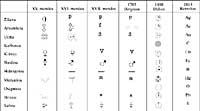Designation of chemical elements
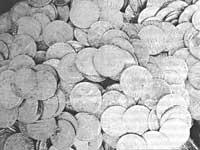
In 1976 the CNIC Commission of the IUPAC (Comission of the Nomenclature of Inorganic Chemistry) recommended the use of systematic names for descendants of element 103.
XX. In the last decades of the twentieth century, discoveries are made by appropriate infrastructure groups or entities. For this reason, it has happened that different groups found the same element at the same time. The problem arises by renaming the discovery.
In 1965, in Dubna, a Russian group manufactured an isotope of element 104 and in 1967 discovered element 105. Likewise, a group of Americans from Berkeley pointed out that these two discoveries were made, namely Element 105 in 1970. The Russians proposed the names of Kurtchatovium for 104 and Nielsbohrium for 105. For their part, the Americans Rutherfordium and Hahnium.
In order to avoid these problems, the above mentioned systematic names were recommended. For example, while 104 is unnilquadium (one = 1, nil = 0, quad = 4 and ium to indicate that the end is metal), the 105 would be unnilpentium.
Without a doubt, through this rule it is easy to know the name of any element (because it is an easy way to name it) and on the other hand it is not necessary to know from memory a group of names, as it happens with other elements.
The time has come, therefore, to mention the second way of designation of elements. We know that throughout history, as they knew new chemical elements, they gave it a name with meaning and not a cold systematic name.
What meaning can we apply to a chemical element? In each epoch different customs have existed. Formerly, nine chemical elements were known, seven of which were metals. Based on one of its physical properties are called gold, silver, iron, mercury, tin, copper and lead.
For example:
- Gold (Au). Aurum, the goddess of the unreleased Aurora. The origin of the word is the sanscrítica thread (yellow).
- Mercury (Hg). The Greek name Hydrargyrum comes from hydro-argyros (silver water) for its shiny liquid metal.
- Silver (Ag). Argentum comes from the word "argunas" (brilliant) of sanscrítica.
- Tin (Sn) comes from the words Stannum, Indo-European stagnum and stag (drop by drop), for its ease of fusion.
The first reference as discoverer of some chemical element is the germanic Hennig Brand. In 1670 he discovered phosphorus trying to get the philosopher. Phosphorus comes from the words Phos- and -phero (illuminator), since in the dark the white phosphorus emits light.
XIX. At the beginning of the twentieth century, the Swedish chemist Jons Jakob Berzelius proposed the symbols currently used. His intention was to express the names by one or two letters, but earlier other symbols were used. These are summarized in Table 1.
The five elements obtained between 1744 and 1811 were called by their color or by the colors of the compounds that composed them.
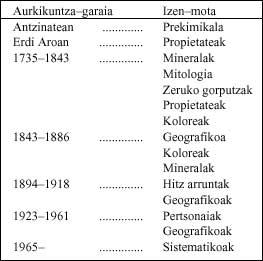
For example:
- Chlorine (Cl). Greek chlorhos means yellow-green because it is the color of the gas.
- Iodine (I). From the Greek Ioeides, purple color, steam color.
- Chrome (Cr). Greek khroma means color. Chromium compounds have different colors.
- Rodio (Rh). The Greek Rhodon is pink, the solutions of rhodium salts are red.
- Iridio (Ir). Greek iris is a rainbow. The solutions of iridium present groups of colors.
Between 1735 and 1843 numerous chemical elements were discovered and, in addition to their properties, they used mythology, celestial bodies and mineral names.
Some examples of mythology:
- Titanium (Ti). In Greek mythology were the Titans, giant sons of the god Uranus (the first inhabitants of the earth).
- Torio (Th). Thor is the Norwegian god of war. J.J. The Swedish Berzelius discovered it in a Norwegian mineral.
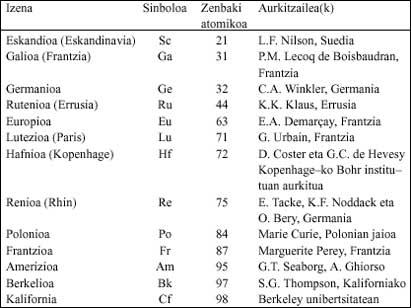
Some examples of celestial bodies:
- Selenium (Se). The Greek word Selene means moon.
- Cerio (Ce). Ceres is the first asteroid to be known. Ce was discovered in 1803, two years after knowing the asteroid. Ceres is the Roman goddess of harvest and wheat.
- Paladium (Pd). The origin of this name is Pallas, second known asteroid. The pallas were found in 1802 and the paladium in 1803. Pallas is the Greek god of wisdom.
Some examples of minerals:
- Calcium (Ca). Kylix in Greek is plaster.
- Bario (Ba). Barys is a heavy Greek word. The barium is a metal located in the heavy esparto Barite (BaSO 4).
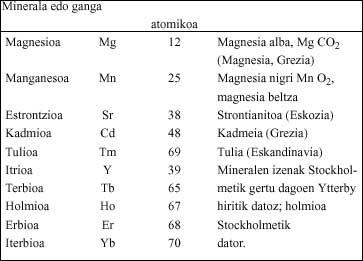
Over the years, new paths have been used and trends have been recovered from other times.
This is summarized in Table 2.
So far, the geographical, common words and examples of characters have not been mentioned. Let's fill this gap.
Common words:
- Lithium (Li). Lithos in Greek: stone.
- Tecno (Tc). Greek technetos: artificial. The first artificially produced element was bombarded by deuterium radioactive molybdenum.
- Kripton (Kr). Greek kryptos, hidden. In the distillation of liquefied air, in addition to nitrogen, oxygen and argon, another element was hidden in the liquid, the crypton.
Names of characters in honor of prestigious researchers:
- Kurio (Marie Curie and Pierre Curie), Einstenio (Albert Einstein), Fermio (Enrico Fermi), Mendelevio (Dimitrii L. Mendeleiev), Novel (Alfred Nobel) and Lawrencio (Ernest O. Lawrence). In addition, the above mentioned Curschatobio (Igor V. Kurtchatov) or Ruterfordio (Ernest Rutherford) and Hahnio (Otto Hahn) or Nielsbohrio (Niels Bohr), although systematic names are currently used for elements 104 and 105.
- Consequently, while non-systematic names are used up to element 103, descendants will have systematic names.



